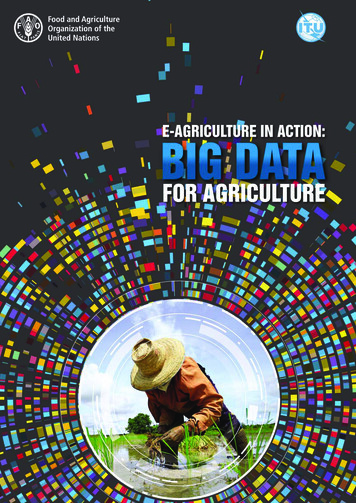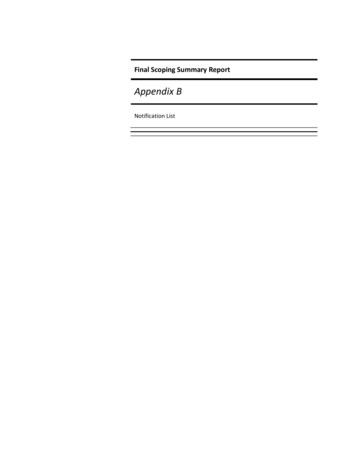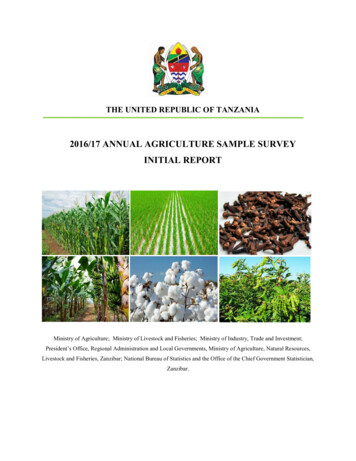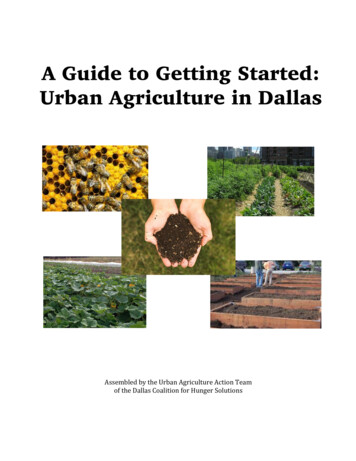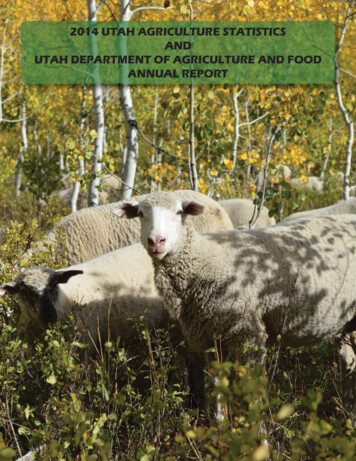
Transcription
2014 UTAH AGRICULTURE STATISTICSANDUTAH DEPARTMENT OF AGRICULTURE AND FOODANNUAL REPORT
Dear Friends,It is my pleasure to present the 2014 Annual Report on the status of Utah agriculture.This has been an excellent year for many of our farmers and ranchers despite the inconsistentpatterns of precipitation we have experienced. Some livestock operators report record prices for theircattle, and our dairy farmers have seen a positive turnaround as well. That is great news for theindustry and consumers.Agriculture and Food Commissioner LuAnn Adams is making strides in connecting Utahnswith our local food producers through the Utah’s Own program. By using a series of statewideeconomic summits, her department is expanding the number of Utah’s Own companies andaccelerating economic activity in Utah. These small to medium-sized employers are responsible for asmany as 10,000 jobs, and they are adding nearly 175 new jobs each year.I believe the best is yet to come for our state and the thousands of family-run farms in Utah.After traveling throughout our state and meeting hundreds of farmers and ranchers, it is clear to meUtah’s agricultural success is ascribed to our people. Their dedication to the land and theircommunities is what makes Utah agriculture the great industry it is.Thank you for supporting Utah agriculture and recognizing the important role this industryplays in our state’s future.Sincerely,Gary R. HerbertGovernor
UTAH DEPARTMENT OF AGRICULTURE AND FOODANNUAL REPORT
Utah Department of Agriculture and FoodAdministrationLuAnn AdamsDepartment Phone Directory - Area Code (801)For information and numbers not listed below.538-7100Internet: http://ag.utah.gov email: larrylewis@utah.govCommissionerScott EricsonCommissioner's OfficeCommissioner. 538-7101Deputy Commissioner . 538-7102Administrative Assistant . 538-7103Public Information Officer . 538-7104Policy Analyst . 538-4976Policy Analyst . 538-7190Administrative ServicesDirector. 538-7110Budget and Accounting . 538-7032GIS . 538-9904Marketing and DevelopmentDirector. 538-7108Deputy Director . . 538-7141Marketing Specialist. 538-4913Livestock & Market News .435-230-0402Animal IndustryDirector/ . 538-7166State Veterinarian . 538-7162Assistant State Veterinarian . 538-4910Animal Health (import permits) . 538-7164Animal Health Desk . 538-7161Brand Bureau Chief . 538-7166Animal Identification (brands) . 538-7137Aquaculture . 538-7046Elk Farming . 538-7166Meat Inspection . 538-7117Chemistry LaboratoryDirector. 538-7128Bacteriology Laboratory . 538-4928Feed & Fertilizer Laboratory. 538-7133Meat Laboratory . 538-7132Pesticide Residue Laboratory . 538-7135Plant IndustryDirector. 538-7180Entomology . 538-7184Fresh Fruit & Vegetable Inspection .435-757-3726Seed, Organic & Fertilizer. 538-7187Grain Grading Lab (Ogden UT) .1-801-392-2292Insect Infestation Emergency Control . 538-7184Noxious Weeds & Feed . 538-7186Pesticides . 538-7183Seed Laboratory . 538-7182Groundwater . 538-9905Grazing Improvement Program (GIP). 435-279-3603Utah Conservation CommissionExecutive Dir. . .538-7120Ag Resource Development Loans (ARDL) . 538-7172Ag. Certificate Environmental Stewardship (ACES) . 538-7120Regulatory ServicesDirector. 538-7150Bedding, Quilted Clothing, & Upholstered Furn. . 538-7151Dairy Compliance . 538-7145Egg & Poultry Compliance . 538-4943Food Compliance . 538-7149Meat Compliance . 538-7149Metrology (measurement) Laboratory . 538-7153Motor Fuels Testing Laboratory . 538-7154Weights & Measures . 538-7158Deputy CommissionerLarry LewisPublic Information OfficerKathleen MathewsAdministrative AssistantMelissa UrePolicy AnalystWayne BradshawPolicy AnalystDivision DirectorsStephen Ogilvie, DirectorAdministrative ServicesJed Christenson, DirectorCody James, DirectorDr. Warren HessMarketing Econ./DevelopmentAnimal IndustryActing State VeterinarianDr. Weston Judd, Director &State ChemistLaboratory Services/ChemistryRobert Hougaard, DirectorPlant Industry & ConservationTravis WallerDr. Chris Crnich, DirectorRegulatory ServicesHomeland SecurityAgricultural Advisory BoardChairman .Leland HoganUtah Farm BureauVice Chairman . Kent BushmanUtah Farmers UnionRon Stratford. Utah Dairymens AssociationTom Boyer .Utah Wool Growers AssociationDon Anderson .Utah Cattlemens AssociationRon Stratford. Utah Dairymens AssociationDolores Wheeler . Food Processing IndustryRusty Bastian .Food Supplement ManufacturersStuart Sprouse .Utah Horse IndustryWendell Stembridge . Utah Assn. of Conservation DistrictsScott Robins . Utah Livestock Marketing AssociationMarilyn K. Albertson .Consumers' RepresentativeDr. Roger Rees . Utah Veterinary Medical AssociationHaven Hendricks . Utah Pork Producers AssociationCliff Lillywhite . Egg & Poultry RepresentativeMatt Cook .Utah Turkey IndustryRobert McMullen . Fruit and Vegetable Association2014 Utah Department of Agriculture and Food Annual Report2
Commissioner of Agricultureand FoodLuAnn AdamsGreetings.As my first year as your Commissioner of Agriculture and Food comes to an endI have the privilege to report to you that agriculture continues to do well in TheBeehive State. I am a life-long farmer/rancher who grew up on an Idaho sugarbeet farm and married a Box Elder County cattle rancher where our family continues to work the range. I have had theprivilege of working with a variety of interests that support agriculture in Utah. I am encouraged that we all seek onlythe best for this important industry.Utah agriculture is moving forward. The number of farms and ranches stands at more than 18,000, an increase overthe past five years. Our farmers are also more productive as yields of crops and livestock have been trending upwardfor the last few years. I am especially impressed with our citizen’s support for Utah agriculture. In our latest WasatchFront public opinion poll, a whopping 95% of Utahns think farming and ranching are important to the future of thestate. And 84% think farmers are responsible stewards of the land.It’s clear they feel the way I do, that our local farmers and ranchers produce the most nutritious, safest and most abundant supply of food in the land. Utahns, as well as people around the country, value locally grown foods. More than 8out of 10 consumers say they want their foods to come from within the United States. Food isn’t the only thing beingharvested on our farm; jobs and positive economic numbers are produced by the bushel. Utah State University reportsthat our industry’s production and processing segments contribute more than 17 billion to our economy and generate78,000 jobs.Our Utah’s Own Program is helping farmers and ranchers by directing consumers to products that are made from locally grown and raised ingredients. We calculate that if Utahns shifted one percent of their food dollar to purchase Utahgrown products instead of national brands, we’d generate 63 million for our state’s economy.I thank you for your interest in Utah agriculture and I invite you to review our annual report to read more about ouragency and our agriculture industry.Sincerely,LuAnn AdamsUtah Commissioner of Agriculture and Food2014 Utah Department of Agriculture and Food Annual Report5
Mission StatementThe mission of the Utah Department of Agriculture and Foodis to “Promote the healthy growth of Utah agriculture, conserveour natural resources and protect our food supply.”It is also believed that a safe food supply is the basis for healthand prosperity. The Department's Vision Statement is: To be therecognized guardian of Utah's food supply and sustainable agriculture.The Department values: Integrity and respectService and hard workStewardship and accountabilityGrowth and achievementPeople and partnershipsHeritage and cultureIn carrying out that mission, Department personnel will takespecific steps in various areas of the state’s agricultural industry,such as the following:RegulationDepartment operations help protect public health and safetyas well as agricultural markets by assuring consumers of clean,safe, wholesome, and properly labeled and measured or weighedproducts. This includes products inspected by UDAF's animalindustry, plant industry, weights and measures, and food anddairy inspectors, compliance officers and field representatives. Itinvolves chemical analysis by the state laboratory, which is partof the Department. It also includes other consumer products suchas bedding, quilted clothing and upholstered furniture.This inspection also protects legitimate producers andprocessors by keeping their markets safe from poor products andcareless processing.Food safety, public health and consumer protection is acritical and essential function of state government. In order toaccomplish this mission, with increased population and industrygrowth, we are identifying ways and means to fund the regulatoryfunctions of the Department. In addition, we continue to educatethe public about the importance of agriculture and the value ofmaintaining a viable agriculture industry.ConservationThrough its variety of programs in this area, the Departmentwill work to protect, conserve and enhance Utah’s agricultural andnatural resources, including water and land, and to administer twolow-interest revolving loan funds aimed at developing resourcesand financing new enterprises.We will promote the responsible stewardship of our state’sland, water and other resources through the best management practices available. We will promote the economic well-being of Utahand her rural citizens by adding value to our agricultural products.We also aggressively seek new markets for our products. And wewill inform the citizens and officials of our state of our work andprogress.Marketing and DevelopmentUDAF marketing section strengthens Utah's agriculture andallied industries financially by expanding present markets anddeveloping new ones for Utah's agricultural products, locally, inthe United States, and overseas as well. It also helps develop newproducts and production methods and promotes instate processingof Utah agricultural products for a stronger state economy.This annual report is available on the Internet at:www.ag.utah.govVisit our website on your mobile device byscanning this Quick Response code.Also visit: od/2014 Utah Department of Agriculture and Food Annual Report6
Commissioner's OfficeThe Utah Senate confirmed Governor Gary R. Herbert's appointment of LuAnn Adams of Box Elder County as the State's7th, and first female, Commissioner of Agriculture and Food inFebruary. Commissioner Adams is a life long farmer/rancherwho works with her husband and five sons and daughters runningtheir cattle ranch west of Brigham City, Utah.Shortly after taking office, Commissioner Adams acceleratedand broadened the Department's Utah's Own Program that stimulates the economy and helps farmers and ranchers by encouragingconsumers to buy products that are made from locally grown andraised ingredients. New for the program this year was a seriesof 14 Utah's Own economic summits held in: Brigham City,Tooele, Kanab, Richfield, Logan, Monticello, Helper, St. George,Kaysville, Cedar City, Manila, Vernal, Orem, and Heber City.The summits are coordinated with local Small Business Development Centers (SBDCs) with the goal of acquainting local foodoriented companies with the benefits of the Utah’s Own program.Participants heard from industry experts on how to market andgrow their businesses. For example, Apple Beer, is now beingsold in most Walmart stores after a Walmart buyer discoveredthe product at a Utah's Own economic summit. The Utah's Ownbrand is working to expand its products into many other retailoutlets including Maverik Convenience stores, Utah State Parks'food and gift shops and other locations. See a video of a Utah'sOwn summit here. http://bit.ly/1yx6IRVKevin Jones, Owner of Snap Daddy's Barbecue Sauce, tells participants in a Utah's Own economic summit how joining Utah'sOwn has helped him improve his marketing and profitability.2014 Utah Department of Agriculture and Food Annual Report7The UDAF made significant progress in working with members of the Utah Conservation Commission, Conservation Districts, and the Utah Association of Conservation Districts toadopt a number of recommendations made by a June 2014 Legislative audit of the Conservation Districts. A three-day work session helped participants understand the concerns expressed in theaudit, and find ways to restructure the UCC/CD/UACD/UDAFrelationship that will assure efficient spending and make the bestuse of general fund dollarsOur Egg Inspection Program received the Governor’s Award ofExcellence this year. TheEgg & Poultry staff wererecognized for consistentlydemonstrating outstandingcontributions to the egg andpoultry producers and consumers of Utah. This staffof graders diligently arriveat Utah's egg and poultryplants in the early morninghours each day to insure thatthe products purchased byUtah consumers are of thebest quality possible.The County Seat televisionshow focused its June 22ndshow on Utah's war againstweeds and the Invasive Species. The focus was on Em- Egg inspection team: (l-r) Superery County and their Russian visor, Cary Wise, Stephanie JaOlive tree removal program. cobs, Sharisa Vodopich, CarlottaThe half hour show includ- Foitzick, Adel Young, with Comed a summary of the project, missioner, LuAnn Adamsshot during a recent tour ofthe rea, and a roundtable discussion abut the war on weeds. Seethe show at: http://bit.ly/1nxgrCT/The USDA completed its audit of our Meat Compliance Programand was very impressed with our methods and collaboration withthe local USDA Compliance Officer. Our Meat Program earnedthe “Equal To” status which is a significant accomplishment.The State Veterinarian’s Office issued an Emergency Order making all livestock shows and fairs “terminal” events to help prevent the spread of PED virus into the state’s swine population.Despite the emergency step, swine at the state’s largest hog farmtested positive for PEDv in September.The Velvet Longhorned Beetle was discovered in Utah andthreatens Utah cherry trees. The insect came from contaminatedpacking material from China.Efforts are underway to confirm the presence of the Emerald AshBorer which will be a threat to ornamental ash trees in Utah.
Deputy CommissionerScott EricsonDeputy CommissionerScott Ericson is responsible for and coordinates all of the dayto day Department activities and works with each division ontheir program budgets and goals. Scott oversees and coordinatesthe Department’s SUCCESS Program that focuses on measurableresults that drive operations and the budgeting process. He alsooversees the Utah Horse Racing Commission and the promulgationof all Department administrative rules. He coordinates thecollection of predator assessment head tax and is the Treasurer forthe Agriculture in the Classroom Program, He is the Department'srepresentative on the state Farmland Evaluation AdvisoryCommittee (Greenbelt).Communications OfficeThe Communications office is an important link between thepublic, industry, employees, and other state agencies. The officepublishes videos, brochures, articles, newsletters, web pages, aswell as create displays and computer presentations. The office alsowrites news releases and responds to news media enquires aboutagriculture and the UDAF. In addition to the printed medium,the office uses video-tape to produce video news releases andvideo clips that can be viewed at youtube.com/utahagriculture/The Department is also active in social media, using Facebookand Twitter. (facebook.com/utahagriculture and twitter.com/utagandfood).The Department launched a redesigned Internet website in2013. The website is organized to better serve the needs of thethousands of visitors who use the Internet to do business withthe State, or simply learn how the historic agency is serving theirneeds. The website features easy-to-access online services, thelatest livestock auction or commodity trading news, pesticide ap-Agriculture Mediation ProgramThe Department continues to provide services to the agriculturecommunity through its USDA Certified Mediation Program. ation-program.html) The program assists farmers and ranchers who face adverseactions in connection with USDA programs. Utah is one of 34certified programs in the country.Utah farmers and ranches who rely on the Certified StateAgriculture Mediation Program to help them through difficulteconomic times have had that valuable service extended after thepassage of the Agriculture Mediation Bill. The program helpsfarmers and ranchers seek confidential advice and counsel toaddress loan problems and disputes before they grow to be toomuch for the producer to handle. The legislation will continueto authorize funding of the Certified State Agriculture MediationProgram for five years. Mediation provides a neutral, confidentialforum to discuss complex issues and build strong workingrelationships with producers, lenders and government agencies.Agriculture in the ClassroomThe mission of AITC is to increase agricultural literacy in Utahby developing a program that improves student awareness aboutagriculture and instills in students an appreciation for our foodand fiber system. This program is necessary because agricultureaffects our quality of life and our environment.The AITC program receives funds from private donors, statefunding sources, and grants. These funds are leveraged to meetthe programs mission through teacher training, and classroommaterials that effectively and efficiently meet the need to increaseagricultural literacy.Administrative Services DivisionThe Division of Administrative Services provides support toall divisions within the department to insure state policies andprocedures are implemented to meet audits conducted throughoutthe year by state finance and the state auditor’s offices. We haveadded new federal grants each year and to date we are trackingmore than 30 federal grants. We are responsible for processingmore than 450 state grants and contracts annually. Purchasingcards are being used by the majority of the field staff, and fewrequests for petty cash reimbursements are being requested byemployeeswww.facebook.com/utahagricultureThe Department's Facebook page is a good source for the latestinteresting videos and articles about Utah agriculture.2014 Utah Department of Agriculture and Food Annual Reportplicator training information, and dozens of other services.The Communications Office also interacts with local schools,offering students lessons on the connection between the farm andour food. A complete list of UDAF news releases is available at:ag.utah.gov/news.html8
Animal & Wildlife Damage PreventionMike LinnellFederal Program DirectorThe Utah Wildlife Services (WS) program is a cooperative effort between the Utah Department of Agriculture and Food andthe U.S. Department of Agriculture. Protecting Utah's agricultureincludes protecting livestock, with the majority of the program'seffort directed at adult sheep, lambs, and calves from predation.Funding for the program comes from a number of sources,including Federal appropriations and State General fund. Livestock producers also contribute through a livestock assessmentnicknamed the "head tax" because it is assessed per head of livestock. Individual producers, livestock associations, and countiesalso make voluntary contributions to the program to pay for contract helicopter flying.Coyotes remain the most problematic predator species in Utah,both in terms of population size and in the amount of livestockthey kill. Calves are vulnerable to coyote predation for a shortperiod just after birth, and the majority of the calf protection isconcentrated in the spring calving season. In the absence of predator management, calf losses would be expected to exceed 5%,however, with predation management in place, losses are keptto well below 1%. Sheep and lambs remain vulnerable to predation throughout the year and the WS program works with sheepproducers to provide protection on spring lambing range, summermountain range, and on winter range in the desert. In the absenceof protective efforts, it is estimated that lamb losses could be ashigh as 30%, but the WS program in Utah keeps predation lossesto less than 5% on a statewide basis.Cougars and bears are also a significant predator of sheep,especially in the summer when sheep and cattle are grazed in themountains. Of the predation on lambs reported to WS, about 40%are by these two predators. Predation management for cougarand bear is implemented on a corrective basis, and does not beginuntil kills are discovered and confirmed by WS. In order to limitlosses caused by cougars or bears, the WS program must be prepared to respond quickly when killing occurs.A significant amount of predation management is necessaryto improve wildlife populations, and the WS program works withthe Utah Division of Wildlife Resources (UDWR) to provide protection where wildlife populations are below objective. To accomplish this, the program utilizes a combination of 39 full timeand seasonal staff, four agency fixed-wing aircraft, two agencyhelicopters, and eight helicopter contractors. In 2014 the program worked in 14 deer units, 11 sage grouse areas, five bighornsheep areas, five pronghorn areas, and eight waterfowl nestingareas, specifically for the protection of native wildlife resources.WS also provided protection for endangered black-footed ferretsand Utah prairie dogs in transplant areas, and conducted feralswine monitoring and removal in specific locations within Utah.To assure that the WS program has no negative environmental consequences, Environmental Assessments (EA's) havebeen completed to assess the impacts of the program. While theprogram is very successful at protecting livestock and selectedwildlife resources, there are no adverse impacts to predator popu2014 Utah Department of Agriculture and Food Annual Report9lations, wetlands and watersheds, or other parts of the environment. Annual monitoring of our program is conducted to assurethat the analyses in the EA's are complete and remain valid.Personnel from the WS program have participated in wolf training as the State prepares for dispersing wolves from recoveringpopulations in adjacent States. A significant amount of time andeffort is necessary to ensure that programs are in place to dealwith wolves as they arrive. Per direction from the Utah Legislature, a wolf management plan has been put in place and the Agriculture and Wildlife Damage Prevention Board has adopted therole prescribed by the plan for the WS program. WS personnelwill be primary responders when livestock are killed by wolves,as well as assist in the capture, radio collaring, and monitoring ofnon-depredating wolves. WS personnel are widely recognizedas the experts in dealing with predator-related problems, and ourskills are needed to assure professional management of wolves asfederally protected wildlife and through the transfer of authorityto a State managed species.The WS program plays a critical role in the early detectionand management of wildlife-borne diseases. WS is conductingsurveillance for early detection of highly pathogenic Avian Influenza. The WS program has assisted the UDWR in the removaland testing of mule deer where the potential transmission ofChronic Wasting Disease is a concern. WS has collected samplesfor plague, tularemia, avian influenza, West Nile virus, raccoonroundworm, and other zoonotic disease monitoring around theState, and responds to mortality events in wild birds to assist indetection of diseases. WS has a full-time wildlife disease biologist position to coordinate rapid response and sampling effortswithin WS and other agencies. Because our personnel are located throughout the State and are experts in back-country workfrom horseback, our help is often solicited in recovery of diseasesamples and even in human search and rescue missions.The WS program also deals with other wildlife related damagethroughout the State, such as wildlife hazards to commercial aviation. In 2014 WS received the National Migratory Bird Stewardship Award from the U.S. Fish and Wildlife Service primarilyfor our role in protecting raptors at airports. WS staff trapped andrelocated over 600 raptors (birds of prey such as hawks, falcons,and owls) from Utah airports in 2014 so they would not be struckby aircraft and threatened human safety. WS also provides technical assistance and training to the public on problems related tourban wildlife involving skunks, raccoons, birds, and other animals. WS continues to conduct disease monitoring in the urbanprogram and responds to human safety cases involving cougarsor bears statewide when assistance is requested by the UDWR.The public, including farmers and ranchers, place a highintrinsic value on wildlife. In order to maintain healthy populations of wildlife and concurrently sustain productive agriculture,a professional wildlife damage management program must be inplace to mitigate the damage while protecting wildlife populations. In Utah the cooperative Wildlife Services program fillsthat need.
Animal IndustryCody JamesDirectorThe Animal Industry Division of the Utah Department of Agriculture and Food has six main programs:1) Animal Health – focused on prevention and control of animaldiseases, with special attention to diseases that can be transmittedto humans.2) Meat and Poultry Inspection — to assure wholesome productsfor consumers.3) Livestock Inspection (brand registration and inspection) — tooffer protection to the livestock industry through law enforcement.4) Fish Health — protecting the fish health in the state and dealingwith problems of fish food production and processing.5) Elk Farming and Elk Hunting Parks – Regulating this domesticlivestock industry with an emphasis on protecting our wild elkpopulation6) Veterinary Diagnostic Laboratories - for disease diagnosis andsurveillance.Major accomplishments in these areas during the past year areas follows:Animal HealthDuring the past year, disease free status was maintained for thefollowing diseases: BrucellosisTuberculosisPseudorabiesSalmonella pullorumMycoplasma gallisepticumDisease monitoring for heartworm, equine encephalitis (Eastern, Western, and West Nile), equine infectious anemia, rabies,brucellosis, tuberculosis, pseudorabies, Salmonella sp., Mycoplasma sp., BSE (Bovine Spongiform Encephalopathy), CWD(Chronic Wasting Disease), trichomoniasis, etc. has continuedduring the past year.More than 17,600 bulls were tested in the trichomoniasis testing program from October 1, 2013 to April 30, 2014. An additional 3,600 bulls were tested after the end of t
Tooele, Kanab, Rich fi eld, Logan, Monticello, Helper, St. George, Kaysville, Cedar City, Manila, Vernal, Orem, and Heber City. The summits are coordinated with local Small Business Devel-opment Centers (SBDCs) with the goal of acquainting local food-oriented companies with the bene fi ts of the Utah's Own program.


